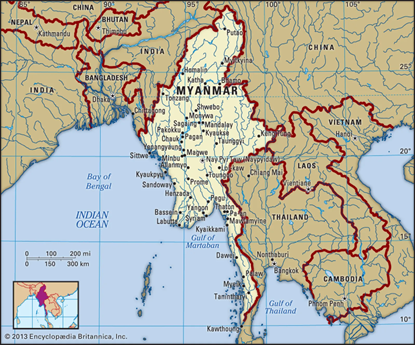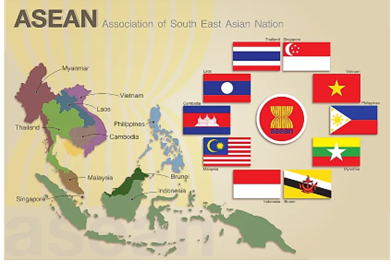Content:
- A picture of a growing economic divide in India
- A collective effort towards peace in Myanmar
A picture of a growing economic divide in India
Context: The EAC-PM report ‘Relative Economic Performance of Indian States: 1960-61 to 2023-24’ highlights deepening regional disparities, with southern and western states outpacing northern and eastern ones in economic growth. Increasing imbalances raise federal concerns.
Relevance: GS 2 (Indian polity ), GS 3 ( Indian Economy )
Practice Question: How does economic disparity among Indian states impact federalism, as highlighted in the recent EAC-PM report? Discuss.(250 words )
Economic Contribution and Inequality Among States
- The report assesses each State’s income contribution to the national economy and their per capita income relative to the all-India average.
- Disparities exist: Maharashtra, a major contributor, shows contrasts between wealthy Mumbai and underdeveloped Vidarbha.
- Intra-state and inter-state disparities highlight differences in regional prosperity.
Regional Disparities and Federal Tensions
- Southern and western regions consistently perform better than eastern and northern States, except for Haryana and Delhi.
- For instance, the highest contributor to the nation’s economy Maharashtra, has a per capita income of about 150% of the national average
- Some states feel they contribute more to the national pool than they receive back.
- For example, the Karnataka and Kerala governments held protests in New Delhi in February 2024.
- Recent conclaves (such as in Kerala) highlight states’ demands for fairer resource distribution and federal support.
Impact of Liberalisation :
- Liberalisation in 1991 marked a turning point, benefiting coastal and southern regions more, with the private sector becoming the key driver of investments.
- Investment disparities:
- Wealthier states attract more private investment than poorer regions.
- The concentration of investments in Mumbai, Delhi, Bengaluru are preferred investment destinations.
Influence of Public vs. Private Sector Investments
- Public investments are often policy-driven and aimed at regional development, whereas private investments, which are 75% of the total investment, prioritise profit, typically focusing on already developed areas.
- Infrastructure, governance quality, and availability of skilled labour make richer states more appealing to investors, deepening regional economic divides.
Role of Financial Sector and Credit Distribution
- Since liberalisation, financial markets have shifted household savings to richer states for higher returns, further depriving poorer states of essential capital.
- A stark contrast is seen in the credit-deposit ratios, with poorer states lagging, reflecting an unequal distribution of financial resources.
Impact on Organised and Unorganised Sectors
- The New Economic Policy (NEP) promotes the organised sector, often at the expense of the unorganised sector predominant in poorer states.
- The expansion of infrastructure, like freight corridors, favours organised businesses, disproportionately boosting wealthier states’ economies.
Special Cases: States with Unique Investment Challenges
- West Bengal and Kerala: Strong Leftist movements and labour activism deter private investment.
- Border states: Less public investment due to strategic and security considerations.
Federalism and the Threat of Regional Imbalances
- Persistent regional disparities threaten the spirit of Indian federalism.
- Federal unity is under threat if development remains skewed, underscoring the need for balanced, inclusive growth.
Suggested Policy Changes:
- Central Role: Shift focus from organized to unorganized sectors in lagging states to boost local incomes and demand.
- State-Level Initiatives: Improve governance, curb corruption, and boost public investment in education, health, and infrastructure.
- Focus on Demand Creation: Strengthening demand in poorer states would attract investment and improve the income base, fostering more equitable growth.
Conclusion:
- A balanced approach would support the growth of all states, reducing disparities and fortifying federalism.
- Sustainable development would protect India’s unity by bridging the economic divide and fostering development.
A collective effort towards peace in Myanmar
Background: Myanmar’s Crisis
- Military Coup (2021): The Military overthrew the democratically elected government, leading to violence and civil war.
- Conflict Dynamics: Involves the military against resistance groups (Ethnic Armed Organisations – EAOs and People’s Defence Forces – PDFs), with resistance controlling significant territories.
- Humanitarian Impact:
- 18.6 million people need aid, including 6 million children.
Relevance: GS 2 (International Relations)
Practice Question: Analyse India’s strategic interests in Myanmar post-coup and discuss the challenges it faces in balancing security concerns with humanitarian assistance. (250 words )

ASEAN’s Approach and Limitations
- Five-Point Consensus: Aims to end violence, promote dialogue, and provide humanitarian assistance.
- Non-Interference Policy Shift: ASEAN recognises the crisis as a violation of its charter, breaking its traditional non-interference stance.
- Exclusion from Summits:
- Myanmar’s military leaders were barred from ASEAN summits due to non-compliance.
- Recent participation by a Myanmar official indicates a pragmatic shift to maintain dialogue.
ASEAN’s Internal Divisions

- Divergent Member State Positions:
- Pro-Action Members: Indonesia, Malaysia, and the Philippines advocate for a stronger stance against the military regime.
- Pro-Engagement Members: Thailand, Cambodia, and Laos maintain close ties with the junta, complicating consensus.
- Informal Diplomatic Initiatives:
- Thailand proposes hosting informal talks with a “Troika” (Indonesia, Laos, Malaysia).
India’s Myanmar Policy
- Strategic Importance:
- Myanmar is crucial for India’s Act East Policy.
- Border and Security Concerns:
- India shares a 1,643 km border with Myanmar
- Project Initiatives:
- Regional Projects: Kaladan Multi-Modal Transit Transport Project and India-Myanmar-Thailand Trilateral Highway.
- Quick Impact Projects: Focus on socio-economic uplift through vocational training and disaster management, supported by a $250,000 grant.
Challenges and Constraints for India
- Border Management Issues:
- Increased instability may lead to refugee influx.
- India need to reconsider the Free Movement Regime
- Inclusive Engagement:India is conducting dialogue with various stakeholders in Myanmar.
Suggested measures
- ASEAN’s Inclusive Diplomacy:
- Engage non-state actors and resistance groups to create an inclusive peace framework.
- India’s Dual Approach:
- Maintain relations with the military for security while supporting democratic processes and addressing humanitarian needs.
- Coordinated ASEAN-India Strategy:
- An inclusive approach involving all Myanmar stakeholders to stabilise the country.
Conclusion
Unified ASEAN-India efforts are essential to address the crisis. Strategic inclusivity and a balanced diplomatic approach will reinforce regional stability and support broader goals.




